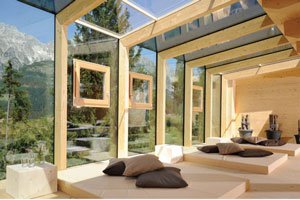
By Sigi Liebmann
Wood is widely promoted as a renewable and environmentally responsible material, based on the third-party certification of sustainable forest management (SFM) practices. While this can be successfully argued at the scale of the forest, until now, the argument has not applied equally at the scale of the building.
All durable wood products will store the carbon they have sequestered while part of a living tree, until destroyed by decay or fire at the end of their service life. However, this remains a cradle to grave evaluation that fails to consider the potential for reclamation and repurposing of the product, the GHG emissions associated with manufacture, and the potential environmental and health impacts of any adhesives used.
As mass timber fabricators, we believe that solid wood is the best material to build with from an ethical standpoint, and that using natural timber, as uncontaminated as possible, is the most sustainable approach to take for the planet and for future generations. This is why we chose to manufacture 100% wood, no-glue dowel laminated timber (DLT), a product that is 100% recyclable, reusable and does not produce contaminated waste.
DLT is a relatively new arrival in Canada, although it has been available in Europe for more than 20 years. To produce DLT, layers of dimension lumber are assembled face to face. A hole is drilled through the entire assembly and a wooden dowel is inserted to hold it all together. No glue, no nails, just the wooden dowel. The wood boards have a moisture content of 10-15%, while the dowels are bone dry. As soon as the dowels are installed and in contact with the surrounding wood, they will absorb the moisture from the boards and expand. This forms a mechanical connection that is incredibly strong.
This type of assembly results in ‘stacked’ DLT panels, so called because ‘stacked’ is a direct translation of the German term ‘Brettstapel’. The surface appearance can be flat or fluted – the latter when 2×4 and 2×6 material is alternated.
In addition to stacked DLT panels there can be crossed DLT panels, a more environmentally responsible product than glue-bonded, cross laminated timber (CLT). In ‘crossed’ DLT, the large sized panels are manufactured by assembling multiple layers of lumber on top of one another, each layer being at different angles to the one below, and pegging them together with hardwood dowels. DLT need not be glued. Windows and doors are left open as the panel is laid up, rather than being cut out from a finished solid panel. This process minimizes the amount of ‘waste’ material produced.
Sigi Liebmann is a Swiss trained master timber framer and owner of International Timberframes Inc. in Golden BC.
SUBSCRIBE TO THE DIGITAL OR PRINT ISSUE OF SABMAGAZINE FOR THE FULL VERSION OF THIS ARTICLE.
